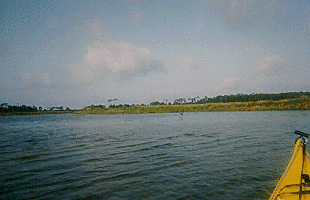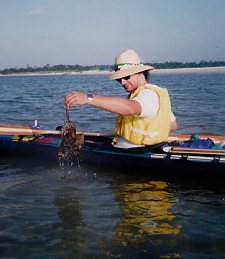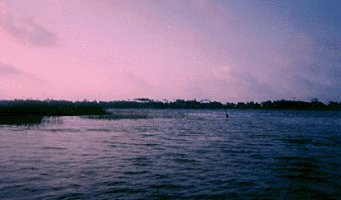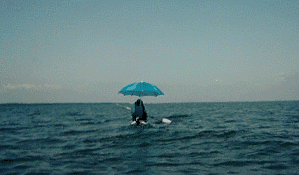GASP! Gulf Area Sea Paddlers
Paddling Mississippi's Barrier Islands - Page 3
Return to last page.
 Leaving the tent intact and gear inside, we paddled the kayaks up the
mouth into the lagoon. A loud "KACK KACK KACK!" was coming from the
reeds. I had heard it during the night. The sound was almost as if
someone was beating two large sticks together. At first, I thought
the sound was coming from an alligator. Soon, we found that a bird,
smaller than a duck was responsible. The sharp sound echoed across the
lagoon disrupting the whistles of the ospreys and calls of the common
loons. Some areas of the lagoon were so shallow, we had to get out of
our boats and wade, pulling the kayaks behind us. We entered another
lagoon, enjoying the morning sun and soft breeze, when I spotted the
distinct shape of an alligator's head on the water's surface. As we
paddled towards the dark image, the alligator submerged.
A short time later, the alligator resurfaced behind us and slowly
moved towards the beach which separated the lagoon from the Sound.
Then it disappeared. We paddled back to camp, loaded the boats and
paddled westward intent on crossing to East Ship Island.
Leaving the tent intact and gear inside, we paddled the kayaks up the
mouth into the lagoon. A loud "KACK KACK KACK!" was coming from the
reeds. I had heard it during the night. The sound was almost as if
someone was beating two large sticks together. At first, I thought
the sound was coming from an alligator. Soon, we found that a bird,
smaller than a duck was responsible. The sharp sound echoed across the
lagoon disrupting the whistles of the ospreys and calls of the common
loons. Some areas of the lagoon were so shallow, we had to get out of
our boats and wade, pulling the kayaks behind us. We entered another
lagoon, enjoying the morning sun and soft breeze, when I spotted the
distinct shape of an alligator's head on the water's surface. As we
paddled towards the dark image, the alligator submerged.
A short time later, the alligator resurfaced behind us and slowly
moved towards the beach which separated the lagoon from the Sound.
Then it disappeared. We paddled back to camp, loaded the boats and
paddled westward intent on crossing to East Ship Island.
Not eager to hurry, we paddled along the shore and were delighted by
hundreds of horseshoe crabs and stingrays. This was mating season for
the horseshoe crabs. We saw many paired together, sometimes a female
swimming with a male attached to her and yet another male attached to
that male. Horseshoe crabs mate in the water, then leave the water to
lay their eggs in the soft sand where any exposed eggs are eaten by
gulls and other sea birds.
We hadn't expected to see so many stingrays. Near shore, they were easy
to spot, but difficult to approach. A huge predator of the stingray is
the hammerhead shark. Hammerhead sharks can reach up to eighteen feet
in length. I wondered if the shadows cast by our long, narrow sea kayaks
resembled the shadow of a hammerhead to the stingrays, for whenever we
approached the stingrays, they darted frantically either away from us or
back and forth between our boats trying to escape into deeper water. One
stingray, caught between Bob's boat and the shore, darted so quickly from
Bob's boat that it temporarily ran itself aground, then darted back out to
sea. They were beautiful to watch, so graceful. They reminded me of birds
in flight under water. Occasionally, if we did not paddle and would only
silently glide along, we would be able to pass over a stingray with no more
than a foot's distance between the stingray and the bottom of the boat.
They can be quick as lightning, or float gracefully along.
 Bob reached in and pulled up a large horseshoe crab by the tail. A
strange creature, it reminded me of a battle helmet with a long tail
attached. The underside looked like a huge bug. He placed the crab
back in the water and returned it to the floor of the Sound.
Unaffected, it crawled along on its way as if its travel had never
been interrupted.
Bob reached in and pulled up a large horseshoe crab by the tail. A
strange creature, it reminded me of a battle helmet with a long tail
attached. The underside looked like a huge bug. He placed the crab
back in the water and returned it to the floor of the Sound.
Unaffected, it crawled along on its way as if its travel had never
been interrupted.
In the hot afternoon sun, we reached the west end of Horn Island. The
meeting of the Gulf of Mexico with the currents of the Sound is quite
apparent in the clapotis formed at the tip of the island. We beached
the boats on the hot sand for a lunch break, erected the umbrellas to
provide relief from the hot sun, and stretched out on the sand gazing
over the blue-green Sound. Beached Portuguese men-of-war were scattered
along the shore. The extreme west end of Horn Island is fairly barren,
with no trees, no shrub, and only sea oats and cordgrass. Three
dolphins appeared about 400 yards from shore, feeding in the Sound,
jumping and splashing. We packed up the lunch gear and paddled from
shore to see if we could spot them. Too late, they were gone. The
feeling is always one of excitement when the dolphins appear on the
scene, free and enjoying the day in the company of each other. Mostly,
they are indifferent to our presence, but occasionally they will come
over to have a look. Then it is we that are entertaining them with a
peek at the unusual, foreign critters.
Because we were enjoying ourselves so much in this bay, watching the
wildlife, scouting the shores for lagoons, we decided we would rather
stay here on Horn than attempt to cross over to East Ship Island, then to
West Ship Island which would leave us no time for leisure exploration.
Deciding that should be another trip at another time, we paddled back
eastward towards the middle of Horn Island where the trees were their
thickest. And what we didn't know, was that this is also where the
bugs were their thickest, and the meanest. We stopped in the late
afternoon several times looking for a campsite for the night. Each
time, the deerflies were merciless in their attack. I climbed high on
the dunes in search of a site which would be clear of trees in order to
catch a continual breeze, all the time swatting at deerflies. When I
turned around to look for Bob, I spotted him standing in the water
about 30 feet from shore. The sea water was the only shelter from the
biting bugs that seemed to have a particularly keen appetite for Bob.
 Eventually, we found ourselves back at the same campsite where we had
spent the previous night, the mouth of the large lagoon. This seemed
to not only be a popular fishing spot for the feathered two-legged
creatures, but also the non-feathered two-legged variety that comes in
noisy power boats. Remembering the night before, we paddled down the
shore away from the mouth of the lagoon. By this time, the sun was
on the horizon. We discovered that it is *exactly* at this time
that another man-eating bug appears on the scene. Far worse than the
deerfly in that it comes in major swarms, covers your body, your
clothes, attempts to fly up your nose and even get into your eyes, and
has a really nasty bite. It was no easy task setting up a tent with
one hand while swatting at bugs with the other. Even an application of
Bug-Off didn't keep them away. They still swarmed and still tried to
fly up my nose.
Eventually, we found ourselves back at the same campsite where we had
spent the previous night, the mouth of the large lagoon. This seemed
to not only be a popular fishing spot for the feathered two-legged
creatures, but also the non-feathered two-legged variety that comes in
noisy power boats. Remembering the night before, we paddled down the
shore away from the mouth of the lagoon. By this time, the sun was
on the horizon. We discovered that it is *exactly* at this time
that another man-eating bug appears on the scene. Far worse than the
deerfly in that it comes in major swarms, covers your body, your
clothes, attempts to fly up your nose and even get into your eyes, and
has a really nasty bite. It was no easy task setting up a tent with
one hand while swatting at bugs with the other. Even an application of
Bug-Off didn't keep them away. They still swarmed and still tried to
fly up my nose.
We gathered all the firewood we could find and built a large fire.
The origin of some of the firewood was highly suspicious as the flames
contained some really strange colors, of pink, and green, and purple.
In the battle of the bugs, we decided the less toxic of the two was the
colorful flames. Finally, after the sun set, so did the bugs... all
over our clothes and the tent. They just weren't biting any more. I
knew they would be silently waiting for us when the sun came up in the
morning. The inside of the tent was covered with them, motionless...
waiting... Could this have been the cause of Walter Anderson's
insanity? Too many island bugs and too many colorful flames? Nah,
his sanity was in question long before he ever reached the islands.
His mental condition most likely aided in his survival of the attacking
bugs. Sometimes, insanity has its virtues.
The next morning, the biting sand gnats did not attack. But the
deerflies made up for the lack of them. Swatting the flies, I think we
hit a record for time spent breaking camp, loading boats and getting on
the water. The water's edge seemed to be the no-pass-no-play point
for the deerflies.
 The sky was clear, the breeze less than five knots and at our backs.
After aligning compasses and checking with the GPS, we headed back to
the mouth of the Pascagoula. Because the breeze was blowing at about
the same speed we were paddling (or less), there was no breeze while
paddling making for a very warm crossing. I tried sailing with the
umbrella but there wasn't enough breeze. Then I tried arranging the
umbrella for shade while I paddled and only succeeded in getting
clobbered in the head.
The sky was clear, the breeze less than five knots and at our backs.
After aligning compasses and checking with the GPS, we headed back to
the mouth of the Pascagoula. Because the breeze was blowing at about
the same speed we were paddling (or less), there was no breeze while
paddling making for a very warm crossing. I tried sailing with the
umbrella but there wasn't enough breeze. Then I tried arranging the
umbrella for shade while I paddled and only succeeded in getting
clobbered in the head.
Progress is difficult to gage on such a flat horizon. The GPS assured
us we were actually getting somewhere and not just sitting in the
middle of the Sound. Miles out from shore, sea life is less
noticeable. No birds flew over our heads, no fish jumped out of the
water. We paddled past a floating pile of broken wood in the middle
of the Intracoastal Waterway. Most likely cargo that was either
deliberately or unknowingly dumped overboard, then, run over by a
passing freighter.
We finally arrived at the mouth of the Pascagoula, paddled up the hot
steamy bayou from which we had originally emerged, and reached the
park where we had spent our first night in Mississippi and where the
car was parked and where we were now being attacked by more biting bugs.
We loaded the car while swatting at bugs, not saying a word for fear if
we opened our mouths, we'd be picking bugs out from between our teeth.
When the gear was loaded, we left Gautier and a swarm of bugs.
As we headed back to Texas and passed all the swamps that we had made
mental notes on the drive out as possible future paddling trips,
noting all the beautiful cypress and pine trees and the remote marshes,
we could only think this time "Bugs. Mean, vicious, bloodsucking,
biting, nose snorting, bugs."
But I'd swear it was worth every minute of it and I'm going back.
Jackie Fenton
************* More Information *****************
More photos of Horn Island...
The barrier islands are a fragile eco-system, home to many rare
species of migratory birds. Please treat them with the respect
they deserve. Campfires are permitted along the shoreline.
The park service asks that you please dump your coals into the
ocean. Please do not leave any trash behind. One of the beautiful
ospreys was found dead in the park strangled by the plastic rings
from a six-pack. No glass bottles are allowed on any of the Mississippi
islands or the Florida beaches. Check with the park rangers about
restricted areas and to give them an itinerary so that they will
know when you are expected to return. The restriction on staying
at least 100 yards from nesting ospreys is still in effect and
should be considered so unless otherwise informed by the park service.
Some areas of the islands are restricted from entry during nesting
season. Signs will be posted. The sea oats and cordgrass aid in
preserving the dunes and therefore, protect the islands. This
fragile vegetation should not be tread upon or camped on.
Many of the barrier islands are from nine to twelve miles from shore
(except for the Chandeleurs which lie even further out). Carry your
drinking water and marine VHF and weather radios. Have all safety
gear and equipment. Paddlers should be experienced in open ocean
paddling and know how to read a compass. Much of the paddling between
islands is open ocean. Storms can appear suddenly as well as fog.
Also remember that the Intracoastal Waterway runs through the
Mississippi Sound. Do not paddle at night without appropriate
lighting. During warmer weather, be prepared for bugs, and take
plenty of water as well as sunblock.
** Gulf Islands National Seashore
Superintendent
3500 Park Road
Ocean Springs, MS 39564
601-875-0821
GORP Gulf
Island's National Seashore" More info on the Islands than the
national park site including maps, wilderness camping, history, etc.
Books:
National Seashores, The Story Behind the Scenery,
KC Publications
** More about Walter Anderson:
Walter Anderson Museum of Art
510 Washington Avenue
Ocean Springs, MS
601-872-3164 |
|
Hours:
Mon-Sat 10:00 - 5:00
Sunday 1:00- 5:00 |
Books:
The Horn Island Logs of Walter Inglis Anderson
Edited by Redding S. Sugg, Jr.
Approaching the Magic Hour, Memories of Walter Anderson
by Agnes (Sissy) Grinstead Anderson
** Other places to visit while in the area:
J.L. Scott Marine Education Center & Aquarium
115 Beach Blvd. (U.S. Hwy 90)
Biloxi, Mississippi 39530
601-374-5550
 Back to GASP's home page
Back to GASP's home page
 Leaving the tent intact and gear inside, we paddled the kayaks up the
mouth into the lagoon. A loud "KACK KACK KACK!" was coming from the
reeds. I had heard it during the night. The sound was almost as if
someone was beating two large sticks together. At first, I thought
the sound was coming from an alligator. Soon, we found that a bird,
smaller than a duck was responsible. The sharp sound echoed across the
lagoon disrupting the whistles of the ospreys and calls of the common
loons. Some areas of the lagoon were so shallow, we had to get out of
our boats and wade, pulling the kayaks behind us. We entered another
lagoon, enjoying the morning sun and soft breeze, when I spotted the
distinct shape of an alligator's head on the water's surface. As we
paddled towards the dark image, the alligator submerged.
A short time later, the alligator resurfaced behind us and slowly
moved towards the beach which separated the lagoon from the Sound.
Then it disappeared. We paddled back to camp, loaded the boats and
paddled westward intent on crossing to East Ship Island.
Leaving the tent intact and gear inside, we paddled the kayaks up the
mouth into the lagoon. A loud "KACK KACK KACK!" was coming from the
reeds. I had heard it during the night. The sound was almost as if
someone was beating two large sticks together. At first, I thought
the sound was coming from an alligator. Soon, we found that a bird,
smaller than a duck was responsible. The sharp sound echoed across the
lagoon disrupting the whistles of the ospreys and calls of the common
loons. Some areas of the lagoon were so shallow, we had to get out of
our boats and wade, pulling the kayaks behind us. We entered another
lagoon, enjoying the morning sun and soft breeze, when I spotted the
distinct shape of an alligator's head on the water's surface. As we
paddled towards the dark image, the alligator submerged.
A short time later, the alligator resurfaced behind us and slowly
moved towards the beach which separated the lagoon from the Sound.
Then it disappeared. We paddled back to camp, loaded the boats and
paddled westward intent on crossing to East Ship Island. Bob reached in and pulled up a large horseshoe crab by the tail. A
strange creature, it reminded me of a battle helmet with a long tail
attached. The underside looked like a huge bug. He placed the crab
back in the water and returned it to the floor of the Sound.
Unaffected, it crawled along on its way as if its travel had never
been interrupted.
Bob reached in and pulled up a large horseshoe crab by the tail. A
strange creature, it reminded me of a battle helmet with a long tail
attached. The underside looked like a huge bug. He placed the crab
back in the water and returned it to the floor of the Sound.
Unaffected, it crawled along on its way as if its travel had never
been interrupted. Eventually, we found ourselves back at the same campsite where we had
spent the previous night, the mouth of the large lagoon. This seemed
to not only be a popular fishing spot for the feathered two-legged
creatures, but also the non-feathered two-legged variety that comes in
noisy power boats. Remembering the night before, we paddled down the
shore away from the mouth of the lagoon. By this time, the sun was
on the horizon. We discovered that it is *exactly* at this time
that another man-eating bug appears on the scene. Far worse than the
deerfly in that it comes in major swarms, covers your body, your
clothes, attempts to fly up your nose and even get into your eyes, and
has a really nasty bite. It was no easy task setting up a tent with
one hand while swatting at bugs with the other. Even an application of
Bug-Off didn't keep them away. They still swarmed and still tried to
fly up my nose.
Eventually, we found ourselves back at the same campsite where we had
spent the previous night, the mouth of the large lagoon. This seemed
to not only be a popular fishing spot for the feathered two-legged
creatures, but also the non-feathered two-legged variety that comes in
noisy power boats. Remembering the night before, we paddled down the
shore away from the mouth of the lagoon. By this time, the sun was
on the horizon. We discovered that it is *exactly* at this time
that another man-eating bug appears on the scene. Far worse than the
deerfly in that it comes in major swarms, covers your body, your
clothes, attempts to fly up your nose and even get into your eyes, and
has a really nasty bite. It was no easy task setting up a tent with
one hand while swatting at bugs with the other. Even an application of
Bug-Off didn't keep them away. They still swarmed and still tried to
fly up my nose. The sky was clear, the breeze less than five knots and at our backs.
After aligning compasses and checking with the GPS, we headed back to
the mouth of the Pascagoula. Because the breeze was blowing at about
the same speed we were paddling (or less), there was no breeze while
paddling making for a very warm crossing. I tried sailing with the
umbrella but there wasn't enough breeze. Then I tried arranging the
umbrella for shade while I paddled and only succeeded in getting
clobbered in the head.
The sky was clear, the breeze less than five knots and at our backs.
After aligning compasses and checking with the GPS, we headed back to
the mouth of the Pascagoula. Because the breeze was blowing at about
the same speed we were paddling (or less), there was no breeze while
paddling making for a very warm crossing. I tried sailing with the
umbrella but there wasn't enough breeze. Then I tried arranging the
umbrella for shade while I paddled and only succeeded in getting
clobbered in the head.